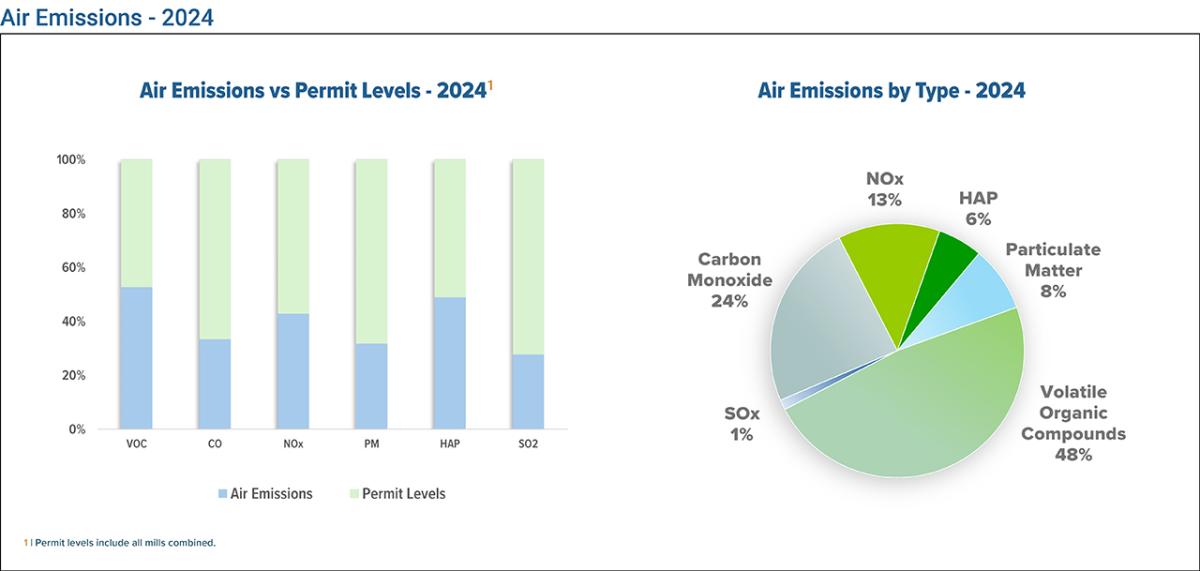How PotlatchDeltic Protects Air Quality

Air emissions from our wood products facilities are generated primarily from the combustion of fuels to generate energy. Combustion of residual wood in boilers that produce steam energy for use in the kilns to dry lumber produces combustion-typical emissions such as carbon monoxide (CO), nitrogen oxides (NOx), sulfur dioxide (SO2), Hazardous Air Pollutants (HAPs), and particulate matter (PM). When drying lumber in a kiln, wood extractives in the form of volatile organic compounds (VOCs), HAPs, and PM (formed from the condensation of VOCs) are released. The air emissions are limited under several federal and state regulatory programs such as the National Emissions Standard for Hazardous Air Pollutants (NESHAP) and New Source Performance Standards (NSPS). The performance standards created by these regulatory programs are implemented at our facilities in permitting programs that establish source-specific operating conditions. These permits guide our facilities in their ongoing efforts to meet the regulatory performance standards.
We regularly measure and report air emissions at each of our facilities and monitor compliance with emission limits for each source and emission type established in our permits. Stack emissions from larger sources like wood-fired boilers are measured by qualified third-party testing companies on a set schedule defined in our permits. The data are regularly collected to verify compliance with various emission limits for select pollutants. We use various technologies at our manufacturing facilities to monitor key emission sources and associated emissions control devices to ensure compliance with applicable air emissions standards. Quality assurance and quality control procedures have been implemented to ensure data integrity and third-party specialists are used to perform periodic maintenance and calibration checks on the facilities that use Continuous Opacity Monitoring Systems. In addition, agency-accepted work practice standards are used to minimize air quality impacts and each site is subject to an internal audit every other year.
We evaluate the operation and maintenance of all our emission sources and their associated control devices. Proper design, operation, and maintenance of the equipment minimizes emissions and is an important part of our air quality commitments. Our facilities also utilize cyclones, baghouses, and/or electrostatic precipitators to control particulate emissions. In addition, our St. Maries, Idaho plywood facility operates special air pollution control equipment to satisfy requirements under applicable regulations. In compliance with the applicable regulations, exhaust from the heated zones of the plywood veneer dryers is collected and routed to a regenerative catalytic oxidizer (RCO) for emissions control.
FORWARD-LOOKING STATEMENTS
This release contains certain forward-looking statements within the meaning of the federal securities laws. Words such as “continuous,” “ongoing,” “periodic,” “regular,” and similar expressions are intended to identify such forward-looking statements. Among the forward-looking statements in this release are statements about air emissions monitoring systems, the steps we take and systems we implement to control our air emissions, and similar matters. These statements reflect management’s views of future events based on assumptions and are therefore subject to known and unknown risks, uncertainties, and other factors, and are not guarantees of future conduct, results, or policies. Please view the Cautionary Statement Regarding Forward-Looking Information on page 32 of PotlatchDeltic’s 2024 Corporate Responsibility Report.

